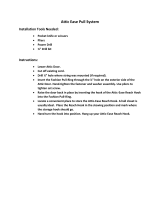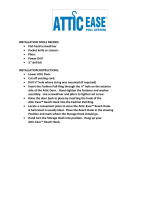
HOW TO RUN WIRES THROUGH EXISTING WALLS USING CABLE BIT TOOLS
You will need: Measuring Tape, Power Drill, Cable Bit for Wood, Lighted Bull Nose Tip or Bull Nose Tipped Fish
Rod, Hook Tip, 2 Fish Rods, Good Quality String
For this example we have removed most of the drywall and insulation from the wall and ceiling giving you a clear view
of what is happening inside the wall.
WARNING: Never use these drills in side a wall that has existing wiring or plumbing!
Measure from the top of the wall
down to the opening you will be
pulling the wire through so you
know when you will be clearing the
top plate. This is to make sure you
do not drill through the roof and to
let you know if you are hitting the
rafter. Rafters are not always in the
same place as the wall studs.
Make sure you are using a drill
bit and extension long enough
to reach and then mark your drill
bit with a piece of tape so you
will know when you should be
breaking through the top plate.
If this is an insulated wall, make
a cut in the insulation at your
opening and make sure you get
the drill bit completely through the
insulation and into the back corner
before starting your power drill.
Start your drill bit into the wall and
aim it into a back corner where the
stud meets the wall. Use the walking
ability of the drill bit to walk it up
the corner by giving it short burst of
rotation with your power drill.
Drilling in a corner will allow you to
easily locate the hole with your sh
rods and will minimize problems with
encountering insulation.
Keep in mind that these bits are not
indestructible so try and keep your
power drill as close to the oor as
possible. This will keep the bit from
arching too much.
A second hand is recommended.
When you reach the re block gently
push the shank into the opening in
the direction of the back corner. This
will straighten out the bit so it will
drill correctly through the obstruction
and not veer off course.
WRONG
DRILLING ANGLE
CORRECT
DRILLING ANGLE
2
31
CORRECT DRILLING ANGLE
WRONG DRILLING ANGLE
MADE IN USA
EAGLE TOOL US www.eagle-tool.us P - 815-459-4177 F - 815-459-4178











